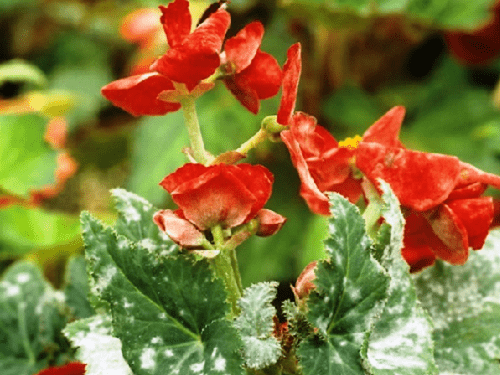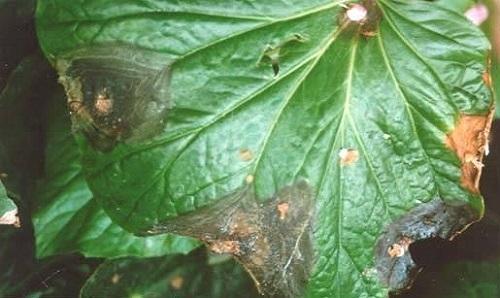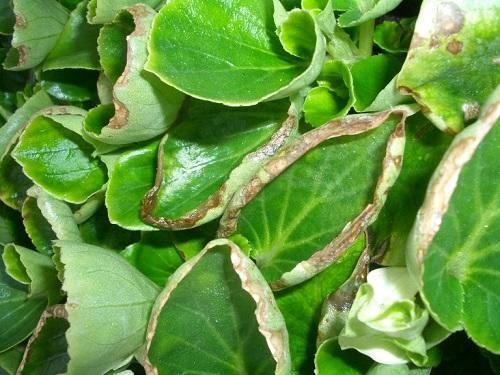Begonia diseases, their treatment
The beauty begonia has a not too capricious character. Subject to the recommendations for caring for the plant, it will delight the eye with a bright green mass and repeated flowering. However, due to various circumstances, it sometimes happens that the general condition of the flower suddenly begins to deteriorate.
Determine the nature of the disease begonias and the appearance of the leaves of the plant will help to start its adequate treatment. The most common diseases of begonias include:
- powdery mildew;
- gray rot;
- vascular bacteriosis;
- scabbard.
Powdery mildew

A symptom of the disease is round brown spots on the leaves with a white coating. The affected area quickly expands to the entire leaflet. The reason for the appearance of powdery mildew is too high a temperature and a low level of humidity in the room where the pot stands.
The affected begonia should be separated from other plants.
If the spots have just appeared, the leaves are sprayed with Fitosporin-M or Alirin-B. In the case when the onset of the disease is missed and all leaves are affected, it is necessary to treat with Topaz or Strobin.
Gray rot

Increased humidity and frequent watering can lead to gray mold disease. At the initial stage, the leaves are covered with gray spots, sticky to the touch. Gradually, the stain expands and leads to rotting of the leaf, as well as the stem itself.
To save the plant, the pot is moved to another place or the humidity in the room is adjusted. Remove diseased leaves, and spray the remaining leaves with a 0.1% solution of Euparen or Fundazole.
Vascular bacteriosis

The edges of the leaves begin to turn yellow and gradually turn brown. The central part of the leaf remains green, but the vessels themselves turn black. It is necessary to cut off diseased leaves, and treat the remaining ones with fungicides.
Shield

At the initial stage, it manifests itself with a sticky bloom. Over time, small brown growths form on the leaves, which can be removed without damaging the leaf itself. A sick begonia should be treated with an insecticide (Aktar).
Diseases that cannot be treated
With the timely detection of damage, begonia can be reanimated with the help of special drugs. However, there are diseases, the presence of which makes begonias a fatal diagnosis:
- Ring spot. It is transmitted by pests and is characterized by the appearance of yellow spots and dead areas on the leaves.

- Bacterial spotting. On the reverse side of the leaf, watery small spots appear, which darken over time and completely affect the entire flower, including the inflorescences.

- Leaf nematode. The leaf edge first fades, retaining its green color, and then gradually dries out. A completely dry leaf is covered with brown spots. The disease is transmitted to the flower through the soil as a result of low temperatures and high humidity.

In these cases, begonia must be destroyed immediately so that the disease is not transmitted to other plants.
Hello!
The underside of the leaves of my elatior begonia is covered with a glossy coating. The plaque is not sticky, like with shield. What could it be?
Thank you in advance!
Observe the temperature and light conditions of the plant. Water only with settled water, and even better with thawed water. The plaque is most likely caused by poor water quality, namely high salt content.
Hello, I put the begonia cuttings in the water for propagation, put down the roots, but a couple of days after a brown spot appeared above the cuttings, like rot, but the top of the cuttings with a leaf is alive. What is this and can the stalk be saved?
In my opinion, he is rotten. If left as is, over time, the rot will rise higher and the entire cutting will disappear. I would cut the top off while it is healthy. Only it is better to root it immediately in the soil, in a greenhouse - this way there is less risk of decay, because the stems of begonias themselves are very juicy and watery.
Large leaves turn red. Small ones are covered with black dots
Hello, on my begonia Griffon scale insect, tell Aktar better to spray or shed the earth?
The maximum effect will be if you spray the plant plus abundantly moisten the topsoil. If necessary, if there are a lot of pests, it is advisable to repeat the treatment after a week.
Thank:)